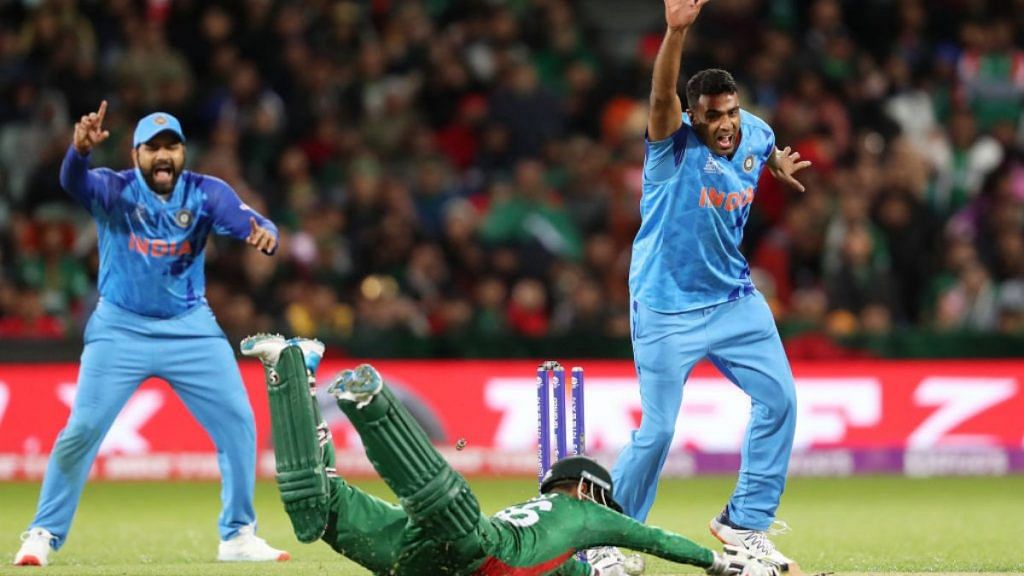New Delhi: Indian fans in Australia’s Adelaide Oval sports ground Wednesday had their hearts in their mouths as rains lashed the area. But Team India recovered from a terrible start to the second innings to record a 5 run victory over Bangladesh, by the Duckworth-Lewis-Stern (DLS) method, in the Men’s T20 World Cup.
The win takes India to the top of the Super 12 group, ahead of South Africa’s encounter with Pakistan in Sydney Friday. While a win for South Africa would likely prevent India’s elimination, India may still need to defeat an already eliminated Zimbabwe at the Melbourne Cricket Ground Sunday in order to confirm its place in the semifinals.
ThePrint takes a look at some key talking points from the match at the Adelaide Oval.
1. Litton gives India a lesson on maximising powerplay
Had the rain not come down, there’s an argument to be made that opener Litton Das could have broken the back of Bangladesh’s chase all by himself. This is because he had raced to a half-century off just 21 balls, all within the powerplay, while his opening partner Nazmul Hossain Shanto was struggling to hit anything off the square. The pitch conditions had become slightly more batting friendly compared to the first innings, but Litton appeared to be batting on a different surface entirely. His approach was high-risk and high-reward, involving expert field manipulations allowed by powerplay restrictions and a confident backing of creative shot selection. In comparison, India’s top three had a far more conservative start to the powerplay. And, given that Bangladesh was ahead of the DLS par score before the rain, India’s top three were given a masterclass in how to make the most runs possible when there are fewer outfielders.
2. Taskin finds Adelaide’s ideal hard lengths in probing spell
Earlier, the Dutch pace attack had broken the back of Zimbabwe’s batting order through disciplined lines and lengths, and giving little to no easy scoring opportunities as they restricted the Chevrons to 117 all out. For the evening game, it appeared as if Bangladesh’s premier express pace bowler Taskin Ahmed had taken a leaf from the Dutch playbook and looked to do the same to India’s top order. Taskin is perhaps the primary reason Bangladesh have won two matches in the Super 12 stage instead of zero, and he was the biggest early threat to India. Throughout the powerplay, Taskin extracted more than enough bounce and swing to prevent KL Rahul and Rohit Sharma from getting comfortable on the Adelaide pitch, and was unlucky to go wicketless. India would have most likely posted a total in excess of 200, were it not for Taskin.
3. Shakib throws inexperienced pacers off the deep end
As explained by Freddie Wilde, cricket analyst and head of performance analysis at data analytics firm CricViz, Bangladesh and their captain Shakib al Hasan performed the ideal tactics in a T20 international game they were not expected to win. They gave their best bowler his entire spell early on to keep the run rate down and create wicket-taking opportunities, put out attacking fields and when batting, played aggressive shots at nearly every delivery.
Despite ending on the wrong side of the result Bangladesh's performance today offers a template for how underdogs should tackle these games: they front-loaded their bowling, set aggressive fields & attacked the Powerplay with the bat. High-risk, high-reward cricket. #T20WorldCup
— Freddie Wilde (@fwildecricket) November 2, 2022
However, where Shakib and the management missed a trick was in the lineup selection. Dropping out-of-form batsman Soumya Sarkar was the right move, but entrusting the inexperienced duo of Hasan Mahmud and Shoriful Islam to share death over duties with Mustafizur Rahman was not. Mahmud picked up three wickets while going for nearly 12 an over. Mustafizur was economical as ever, but Shoriful was dispatched to all parts of the Adelaide Oval. Never quite getting his lengths right and overstepping more than once, the 21-year-old Shoriful should have perhaps made way for the 28-year-old Ebadot Hossain.
4. India’s fielding shows marked improvement
After missing a multitude of key chances in their defeat to South Africa at Perth, India had a significantly superior performance in the field, especially after the outfield had become more damp due to the showers. They took all their catches and did well to prevent easy twos, but more importantly, the match’s turning point in India’s favour also came from an excellent piece of fielding. Having observed how Litton had been putting India’s fielders and bowlers under tremendous pressure with his show of attacking intent, KL Rahul made Litton and Shanto pay for looking for a risky two by throwing a direct hit from the deep. A diving Litton was found well short of his crease and India had made the first of many crucial blows on the way to a victory, despite not being the better side for large periods of the game.
Also read: Cricket-South Africa must bring their bring ‘A-game’ against Pakistan: Miller
